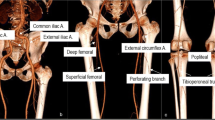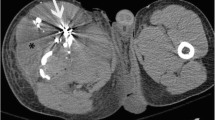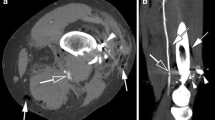Abstract
Successful management of upper extremity arterial injury requires fast and accurate diagnosis. The rate of limb preservation depends on the location, severity, and time of ischemia. Indications for diagnostic imaging depend on the mechanism and type of injury, clinical signs, cardiovascular stability, and clinical suspicion. Because of ease of access, speed, and high accuracy for this diagnosis, multidetector computed tomographic (MDCT) angiography is often used as the first line imaging modality. MDCT systems with 64 slice configuration and more afford high temporal and spatial high-resolution, isotropic data acquisition and integration with whole-body trauma MDCT protocols. The use of individual injection timing protocols ensures high diagnostic image quality. Several strategies are available to reduce radiation exposure. Direct MDCT angiography findings of arterial injuries include active extravasation, luminal narrowing, lack of luminal contrast opacification, filling defect, arteriovenous fistula, and pseudoaneurysm. Important descriptors are location and length of defect, degree of luminal narrowing, and presence of distal arterial supply reconstitution. Proximal arterial injuries include the subclavian, axillary, and brachial arteries. Distal arterial injuries include the ulnar and radial arteries, as well as the palmar arterial arches. Concomitant venous injury, musculoskeletal injury, and nerve damage are common. In this exhibit, we outline the role of MDCT angiography in the diagnosis and management of upper extremity arterial injury, discuss strategies for MDCT angiography acquisition and concepts of data visualization, and illustrate various types of injuries.













Similar content being viewed by others
References
Bogdan MA, Klein MB, Rubin GD, McAdams TR, Chang J (2004) CT angiography in complex upper extremity reconstruction. J Hand Surg (Br) 29:465–469
Fields CE, Latifi R, Ivatury RR (2002) Brachial and forearm vessel injuries. Surg Clin North Am 82:105–114
Hunt CA, Kingsley JR (2000) Vascular injuries of the upper extremity. South Med J 93:466–468
McCroskey BL, Moore EE, Pearce WH, Moore FA, Cota R, Sawyer JD (1988) Traumatic injuries of the brachial artery. Am J Surg 156:553–555
Franz RW, Goodwin RB, Hartman JF, Wright ML (2009) Management of upper extremity arterial injuries at an urban level I trauma center. Ann Vasc Surg 23:8–16
Franz RW, Skytta CK, Shah KJ, Hartman JF, Wright ML (2012) A five-year review of management of upper-extremity arterial injuries at an urban level I trauma center. Ann Vasc Surg 26:655–664
Novelline RA, Rhea JT, Rao PM, Stuk JL (1999) Helical CT in emergency radiology. Radiology 213:321–339
Rivas LA, Fishman JE, Munera F, Bajayo DE (2003) Multislice CT in thoracic trauma. Radiol Clin North Am 41:599–616
Geijer M, El-Khoury GY (2006) MDCT in the evaluation of skeletal trauma: principles, protocols, and clinical applications. Emerg Radiol 13:7–18
Kalra N, Khandelwal N, Gupta P et al (2008) MDCT arteriographic spectrum in acute blunt peripheral trauma—a pictorial review. Emerg Radiol 15:91–97
Murakami AM, Anderson SW, Soto JA, Kertesz JL, Ozonoff A, Rhea JT (2009) Active extravasation of the abdomen and pelvis in trauma using 64MDCT. Emerg Radiol 16:375–382
Uyeda J, Anderson SW, Kertesz J, Soto JA (2010) Pelvic CT angiography: application to blunt trauma using 64MDCT. Emerg Radiol 17:131–137
Schroeder JW, Baskaran V, Aygun N (2010) Imaging of traumatic arterial injuries in the neck with an emphasis on CTA. Emerg Radiol 17:109–122
Jens S, Kerstens MK, Legemate DA, Reekers JA, Bipat S, Koelemay MJ (2013) Diagnostic performance of computed tomography angiography in peripheral arterial injury due to trauma: a systematic review and meta-analysis. Eur J Vasc Endovasc Surg 46(3):329–337
AbuRahma AF, Robinson PA, Boland JP et al (1993) Complications of arteriography in a recent series of 707 cases: factors affecting outcome. Ann Vasc Surg 7:122–129
Mahesh M (2002) Search for isotropic resolution in CT from conventional through multiple-row detector. Radiographics 22:949–962
Anderson SW, Lucey BC, Rhea JT, Soto JA (2007) 64 MDCT in multiple trauma patients: imaging manifestations and clinical implications of active extravasation. Emerg Radiol 14:151–159
Anderson SW, Foster BR, Soto JA (2008) Upper extremity CT angiography in penetrating trauma: use of 64-section multidetector CT. Radiology 249:1064–1073
Tan TW, Joglar FL, Hamburg NM et al (2011) Limb outcome and mortality in lower and upper extremity arterial injury: a comparison using the National Trauma Data Bank. Vasc Endovascular Surg 45:592–597
Rose SC, Moore EE (1988) Trauma angiography of the extremity: the impact of injury mechanism on triage decisions. Cardiovasc Intervent Radiol 11:136–139
Rozycki GS, Tremblay LN, Feliciano DV, McClelland WB (2003) Blunt vascular trauma in the extremity: diagnosis, management, and outcome. J Trauma 55:814–824
Wagner WH, Yellin AE, Weaver FA, Stain SC, Siegel AE (1994) Acute treatment of penetrating popliteal artery trauma: the importance of soft tissue injury. Ann Vasc Surg 8:557–565
Abouezzi Z, Nassoura Z, Ivatury RR, Porter JM, Stahl WM (1998) A critical reappraisal of indications for fasciotomy after extremity vascular trauma. Arch Surg 133:547–551
Cikrit DF, Dalsing MC, Bryant BJ, Lalka SG, Sawchuk AP, Schulz JE (1990) An experience with upper-extremity vascular trauma. Am J Surg 160:229–233
Diamond S, Gaspard D, Katz S (2003) Vascular injuries to the extremities in a suburban trauma center. Am Surg 69:848–851
Myers SI, Harward TR, Maher DP, Melissinos EG, Lowry PA (1990) Complex upper extremity vascular trauma in an urban population. J Vasc Surg 12:305–309
Pillai L, Luchette FA, Romano KS, Ricotta JJ (1997) Upper-extremity arterial injury. Am Surg 63:224–227
Frykberg ER (1995) Advances in the diagnosis and treatment of extremity vascular trauma. Surg Clin North Am 75:207–223
Frykberg ER, Dennis JW, Bishop K, Laneve L, Alexander RH (1991) The reliability of physical examination in the evaluation of penetrating extremity trauma for vascular injury: results at one year. J Trauma 31:502–511
Feliciano DV (2010) Management of peripheral arterial injury. Curr Opin Crit Care 16:602–608
Korn A, Fenchel M, Bender B et al (2013) High-pitch dual-source CT angiography of supra-aortic arteries: assessment of image quality and radiation dose. Neuroradiology 55:423–430
Foster BR, Anderson SW, Uyeda JW, Brooks JG, Soto JA (2011) Integration of 64-detector lower extremity CT angiography into whole-body trauma imaging: feasibility and early experience. Radiology 261:787–795
Dreizin D, Munera F (2012) Blunt polytrauma: evaluation with 64-section whole-body CT angiography. Radiographics 32:609–631
Coursey CA, Nelson RC, Boll DT et al (2010) Dual-energy multidetector CT: how does it work, what can it tell us, and when can we use it in abdominopelvic imaging? Radiographics 30:1037–1055
Vlahos I, Chung R, Nair A, Morgan R (2012) Dual-energy CT: vascular applications. AJR Am J Roentgenol 199:S87–S97
Namasivayam S, Kalra MK, Torres WE, Small WC (2006) Adverse reactions to intravenous iodinated contrast media: a primer for radiologists. Emerg Radiol 12:210–215
Tamm EP, Rong XJ, Cody DD, Ernst RD, Fitzgerald NE, Kundra V (2011) Quality initiatives: CT radiation dose reduction: how to implement change without sacrificing diagnostic quality. Radiographics 31:1823–1832
Lee MJ, Kim S, Lee SA et al (2007) Overcoming artifacts from metallic orthopedic implants at high-field-strength MR imaging and multi-detector CT. Radiographics 27:791–803
Gunn ML, Kohr JR (2010) State of the art: technologies for computed tomography dose reduction. Emerg Radiol 17:209–218
Kalra MK, Rizzo SM, Novelline RA (2005) Reducing radiation dose in emergency computed tomography with automatic exposure control techniques. Emerg Radiol 11:267–274
Kalra MK, Rizzo SM, Novelline RA (2005) Technologic innovations in computer tomography dose reduction: implications in emergency settings. Emerg Radiol 11:127–128
Beister M, Kolditz D, Kalender WA (2012) Iterative reconstruction methods in X-ray CT. Phys Med 28:94–108
Pontana F, Pagniez J, Duhamel A et al (2013) Reduced-dose low-voltage chest CT angiography with Sinogram-affirmed iterative reconstruction versus standard-dose filtered back projection. Radiology 267:609–618
Huda W (2009) What ER radiologists need to know about radiation risks. Emerg Radiol 16:335–341
Meinel FG, Bischoff B, Zhang Q, Bamberg F, Reiser MF, Johnson TR (2012) Metal artifact reduction by dual-energy computed tomography using energetic extrapolation: a systematically optimized protocol. Invest Radiol 47:406–414
Calhoun PS, Kuszyk BS, Heath DG, Carley JC, Fishman EK (1999) Three-dimensional volume rendering of spiral CT data: theory and method. Radiographics 19:745–764
Fishman EK, Ney DR, Heath DG, Corl FM, Horton KM, Johnson PT (2006) Volume rendering versus maximum intensity projection in CT angiography: what works best, when, and why. Radiographics 26:905–922
Pretorius ES, Fishman EK (1999) Volume-rendered three-dimensional spiral CT: musculoskeletal applications. Radiographics 19:1143–1160
Inaba K, Potzman J, Munera F et al (2006) Multi-slice CT angiography for arterial evaluation in the injured lower extremity. J Trauma 60:502–506
Addis KA, Hopper KD, Iyriboz TA et al (2001) CT angiography: in vitro comparison of five reconstruction methods. AJR Am J Roentgenol 177:1171–1176
Uglietta JP, Kadir S (1989) Arteriographic study of variant arterial anatomy of the upper extremities. Cardiovasc Intervent Radiol 12:145–148
Gellman H, Botte MJ, Shankwiler J, Gelberman RH (2001) Arterial patterns of the deep and superficial palmar arches. Clin Orthop Relat Res 41–46
Tsuruo Y, Ueyama T, Ito T et al (2006) Persistent median artery in the hand: a report with a brief review of the literature. Anat Sci Int 81:242–252
Pieroni S, Foster BR, Anderson SW, Kertesz JL, Rhea JT, Soto JA (2009) Use of 64-row multidetector CT angiography in blunt and penetrating trauma of the upper and lower extremities. Radiographics 29:863–876
Fritz J, Efron DT, Fishman EK (2013) State-of-the-art 3DCT angiography assessment of lower extremity trauma: typical findings, pearls, and pitfalls. Emerg Radiol 20:175–184
Conflict of interest
The authors declare that they have no conflict of interest.
Author information
Authors and Affiliations
Corresponding author
Rights and permissions
About this article
Cite this article
Fritz, J., Efron, D.T. & Fishman, E.K. Multidetector CT and three-dimensional CT angiography of upper extremity arterial injury. Emerg Radiol 22, 269–282 (2015). https://doi.org/10.1007/s10140-014-1288-z
Received:
Accepted:
Published:
Issue Date:
DOI: https://doi.org/10.1007/s10140-014-1288-z




